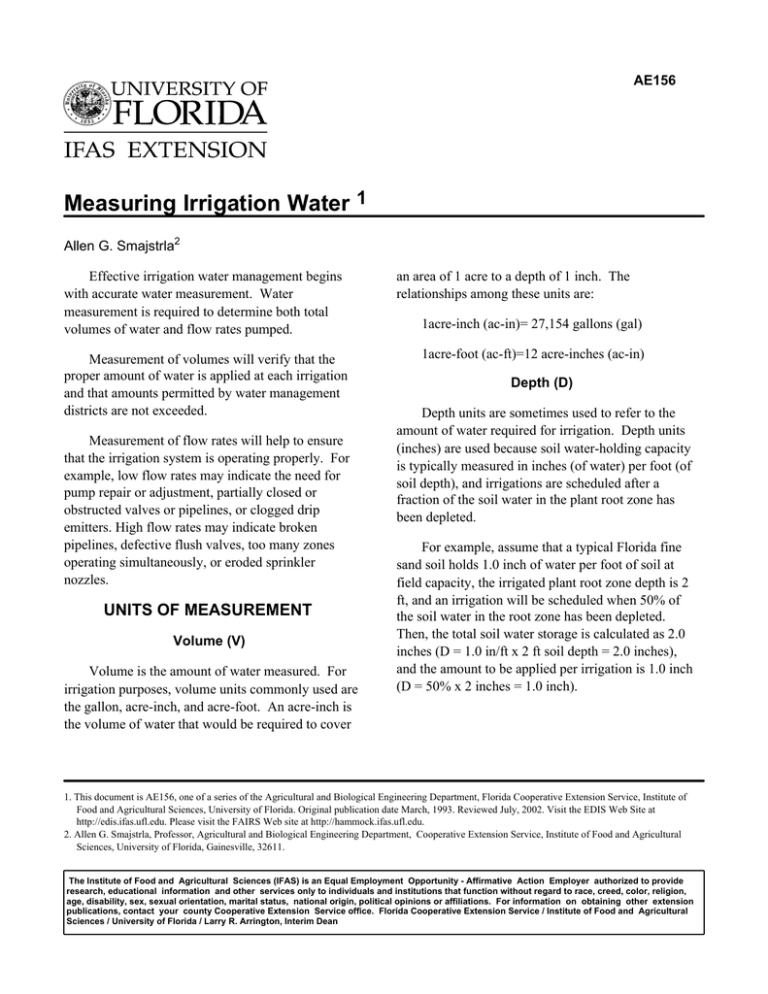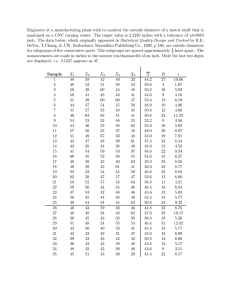Measuring Irrigation Water
advertisement

AE156 Measuring Irrigation Water 1 Allen G. Smajstrla2 Effective irrigation water management begins with accurate water measurement. Water measurement is required to determine both total volumes of water and flow rates pumped. Measurement of volumes will verify that the proper amount of water is applied at each irrigation and that amounts permitted by water management districts are not exceeded. Measurement of flow rates will help to ensure that the irrigation system is operating properly. For example, low flow rates may indicate the need for pump repair or adjustment, partially closed or obstructed valves or pipelines, or clogged drip emitters. High flow rates may indicate broken pipelines, defective flush valves, too many zones operating simultaneously, or eroded sprinkler nozzles. UNITS OF MEASUREMENT Volume (V) Volume is the amount of water measured. For irrigation purposes, volume units commonly used are the gallon, acre-inch, and acre-foot. An acre-inch is the volume of water that would be required to cover an area of 1 acre to a depth of 1 inch. The relationships among these units are: 1acre-inch (ac-in)= 27,154 gallons (gal) 1acre-foot (ac-ft)=12 acre-inches (ac-in) Depth (D) Depth units are sometimes used to refer to the amount of water required for irrigation. Depth units (inches) are used because soil water-holding capacity is typically measured in inches (of water) per foot (of soil depth), and irrigations are scheduled after a fraction of the soil water in the plant root zone has been depleted. For example, assume that a typical Florida fine sand soil holds 1.0 inch of water per foot of soil at field capacity, the irrigated plant root zone depth is 2 ft, and an irrigation will be scheduled when 50% of the soil water in the root zone has been depleted. Then, the total soil water storage is calculated as 2.0 inches (D = 1.0 in/ft x 2 ft soil depth = 2.0 inches), and the amount to be applied per irrigation is 1.0 inch (D = 50% x 2 inches = 1.0 inch). 1. This document is AE156, one of a series of the Agricultural and Biological Engineering Department, Florida Cooperative Extension Service, Institute of Food and Agricultural Sciences, University of Florida. Original publication date March, 1993. Reviewed July, 2002. Visit the EDIS Web Site at http://edis.ifas.ufl.edu. Please visit the FAIRS Web site at http://hammock.ifas.ufl.edu. 2. Allen G. Smajstrla, Professor, Agricultural and Biological Engineering Department, Cooperative Extension Service, Institute of Food and Agricultural Sciences, University of Florida, Gainesville, 32611. The Institute of Food and Agricultural Sciences (IFAS) is an Equal Employment Opportunity - Affirmative Action Employer authorized to provide research, educational information and other services only to individuals and institutions that function without regard to race, creed, color, religion, age, disability, sex, sexual orientation, marital status, national origin, political opinions or affiliations. For information on obtaining other extension publications, contact your county Cooperative Extension Service office. Florida Cooperative Extension Service / Institute of Food and Agricultural Sciences / University of Florida / Larry R. Arrington, Interim Dean Measuring Irrigation Water Note that the amount of water to be pumped will need to be greater than the 1.0 inch to be stored in the plant root zone because some water will be lost during application. That is, application efficiencies are always less than 100 percent because of water losses due to such factors as evaporation, wind drift, and nonuniform water application. Depth units are also convenient for comparison with rainfall depths. For example, a 1-inch rainfall would supply the same volume of water as the 1-inch irrigation in the previous example. Either the 1-inch rain or irrigation would be adequate to restore the soil water content to field capacity. Finally, plant water use (evapotranspiration, ET) rates are typically expressed in (fractions of) inches per day. For example, if the plant ET rate in the previous example is 0.25 in/day, then the allowable soil water depletion of 1.0 inch will occur in four days (1.0 inch / 0.25 inches/day = 4 days), and an irrigation would be required beginning on day 5 to avoid depleting more than 50% of the available soil water in the plant root zone. The calculation of 1.0 inch of water to be applied means that a depth of 1.0 inch is to be applied over the entire area to be irrigated. If the irrigated area is 1.0 acre, then the volume to be applied is 1.0 ac-in (V = 1.0 inch depth x 1.0 acre = 1.0 ac-in) or 27,154 gal. Likewise, if the irrigated area is 20 acres, the volume of water required is 20 ac-in or 543,080 gal (V = 20 ac-in x 27, 154 gal/ac-in = 543,080 gal). Thus, depth units are used interchangeably with volume units because it is convenient to use depth units when referring to soil water depletion, rainfall, and plant ET rates, but volume units when referring to amounts of water permitted or pumped. Flow Rate (Q) Flow rate is the volume of water flowing past a given point per unit of time. The units of flow rate commonly used for irrigation purposes are gallons per minute (gal/min or gpm) and acre-inches per hour (ac-in/hr). The water management districts often use million gallons per day (mgd) for permitting of water extraction rates from a water source. The relationships between these units are: 2 1 gal/min = 0.00221 ac-in/hr = 0.00144 mgd 1 ac-in/hr = 453 gal/min = 0.652 mgd 1 mgd = 694 gal/min = 1.53 ac-in/hr Since flow rate is volume per unit time, the volumes of water applied during irrigation can be calculated if the flow rate and irrigation duration (time) are known. For example, if an irrigation pump discharges 453 gpm and irrigates for 6 hours, the volume of water applied is 163,080 gal (V= 453 gal/min x 60 min/hr x 6 hr = 163,080 gal). This is equivalent to 6.0 ac-in (V = 163,080 gal/ 27,154 gal/ac-in = 6.0 ac-in). Flow rates can be converted to water application rates over the irrigated area if the size of the irrigated area is known. Water application rates from sprinkler irrigation systems are typically given in in/hr, consistent with rainfall rates. If, in the previous example, a sprinkler irrigation system applies water at 453 gpm, and the irrigated area is 4 acres, then the application rate is 0.25 in/hr (453 gpm = 1.0 ac-in/hr, and 1.0 ac-in/hr / 4 acres = 0.25 in/hr). Finally, the depth of water applied can be calculated by multiplying the application rate by the duration of irrigation. Continuing the previous example, for an application rate of 0.25 in/hr and a 6 hr irrigation duration, the gross depth of water applied would be 1.5 inches (D = 0.25 in/hr x 6 hr=1.5 inches). Note that the actual depth of water stored in the plant root zone and available for plant use would be less than 1.5 inches because of water losses during application. A typical application efficiency for sprinkler irrigation systems is 75% for Florida conditions. Thus, only 1.13 inches (1.5 inches x 75% = 1.13 inches) of the 1.5 inches pumped would be expected to be stored in the root zone and available for plant use. Velocity (v) Velocity is the average speed at which water moves in the direction of flow. The velocity unit commonly used is feet per second (ft/sec or fps). To aid in understanding the size of this unit, it is compared with a more familiar unit: Measuring Irrigation Water 1 ft/sec = 0.68 miles per hour (mph) To avoid excessive pressure losses due to friction and excessive potentially damaging surge pressures, most irrigation systems are designed to avoid velocities that exceed 5 ft/sec: 5 ft/sec = 3.4 mph Irrigation water velocities and flow rates are sometimes mistakenly used interchangeably. Velocity and flow rate are two different (but related) concepts. Their relationship is given by the equation of continuity, a fundamental physical law: Q=av where Q= flow rate, 3 pipe will be 4 times greater (inversely proportional to the ratio of the cross-sectional areas) than the velocity in the 2-inch pipe. SUMMARY The amount of irrigation water pumped, applied, or used can be measured in volume or depth units. These units can be used interchangeably when it is convenient to do so. That is, the volume can be calculated from the depth applied if the area is known over which the depth was applied. The pumping rate, application rate, or plant water use rate is measured in units of volume (or depth) per unit of time. The volume can be calculated from the flow rate times the duration (time) of flow. The depth of application or use can be calculated from the application or use rate times the duration (time) of application or use. a = cross-sectional area of flow, and v = velocity. The equation of continuity states that the flow rate can be calculated from the multiple of the velocity times the cross-sectional area of flow. In pipes flowing full, the cross-sectional area of flow is the cross-sectional area of the pipe. In open channel flow, it is the cross sectional area of the channel or stream. Thus, the equation of continuity simply states that in addition to the velocity of flow, the size of the stream or pipe also affects the flow rate. As an example of the application of the equation of continuity, if the velocity is the same in a 1-inch and a 2-inch diameter pipe, the flow rate from the 2 inch pipe would be four times as large as the flow rate from the 1-inch diameter pipe. Note that the cross-sectional area is proportional to the diameter squared and 1 inch squared = 1 inch x 1 inch = 1 square inch, while 2 inches squared = 2 inches x 2 inches = 4 square inches. From this example, doubling the pipe diameter increases the carrying capacity of a pipe by a factor of 4. As another example, if the previously-described 1-inch and 2-inch diameter pipes must both convey the same flow rate, then the velocity in the 1-inch Velocity refers to the speed at which water flows (distance per unit time) as opposed to flow rate (volume per unit time). Thus, the terms flow rate and velocity cannot be used interchangeably. Both the velocity and cross-sectional area of flow must be known in order to calculate flow rates.


